Water Quality
Ground and Surface
Learning Objectives:
- Define water quality and its significance in hydrology and environmental engineering.
- Identify and describe key water quality parameters, including temperature, pH, dissolved oxygen, turbidity, nutrients (nitrogen and phosphorus), and common contaminants (e.g., heavy metals, organic compounds).
Water quality refers to the chemical, physical, biological, and radiological characteristics of water. Common parameters for assessing water quality include temperature, pH, dissolved oxygen (DO), turbidity, nutrients (nitrogen and phosphorus), and contaminants (e.g., heavy metals and organic compounds).
Acidity and Alkalinity:
Acidity and alkalinity are measures of water's ability to neutralize acids or bases, respectively. These parameters are important for evaluating water's corrosiveness and its impact on aquatic life.- Acidity: It results from the presence of hydrogen ions (H+) in water and is measured using pH (potential of hydrogen) scale. A pH value less than 7 indicates acidic water, which can corrode pipes and harm aquatic ecosystems.
- Alkalinity: It is the water's capacity to resist changes in pH, often due to the presence of carbonates and bicarbonates. Alkaline water (pH above 7) can help buffer against pH fluctuations and is less corrosive.
Turbidity:
Turbidity measures the cloudiness or haziness of water, primarily caused by the presence of suspended particles, such as silt, clay, and organic matter. High turbidity can reduce water clarity, making it aesthetically unpleasant and interfering with UV disinfection processes in water treatment. It's a key parameter in assessing the effectiveness of water treatment methods and ensuring water meets aesthetic and safety standards.

U.S. Geological Survey, Public domain, via Wikimedia Commons
Photo of three glass vials shows turbidity standards of 5, 50, and 500 NTUs
Hardness:
Hardness in water is primarily attributed to the presence of calcium and magnesium ions. It's a vital parameter in civil engineering because hard water can lead to scale buildup in pipes and appliances. Two types of hardness exist:- Temporary Hardness: Caused by the presence of bicarbonate ions (HCO3-) that can be removed by boiling or through the addition of lime.
- Permanent Hardness: Attributed to the presence of sulfate, chloride, and nitrate ions, it cannot be removed by boiling and requires ion exchange or chemical softening processes. Managing water hardness is crucial for preventing scale buildup and extending the lifespan of plumbing systems and appliances.
Total Dissolved Solids (TDS):
Total Dissolved Solids is a measure of the concentration of inorganic and organic substances dissolved in water. It includes minerals, salts, metals, and other ions. High TDS levels can affect the taste and safety of drinking water. In civil engineering, monitoring TDS is essential for ensuring water quality in water treatment plants and distribution systems.
Total Suspended Solids (TSS):
Total Suspended Solids represent the concentration of particles that are suspended in water but not dissolved. TSS can include silt, sediment, and organic matter. High TSS levels can impact water clarity, clog filters, and reduce the effectiveness of treatment processes. Civil engineers must manage TSS to maintain water quality standards.
Chemical Parameters:
Various chemical parameters, such as the presence of heavy metals (e.g., lead, arsenic), organic compounds (e.g., pesticides, industrial pollutants), and disinfection byproducts (e.g., trihalomethanes), are critical for assessing water quality. Civil engineers work to remove or mitigate these contaminants to ensure safe and clean drinking water.
Solved Example: 9140-10
Which of the following method is used to forecast the population of old and very large city?
A. Arithmetical increase method
B. Geometric progression method
C. Graphical method
D. Logistic curve method
Correct Answer: A
Solved Example: 9442-01
hich of the following is a common indicator of organic pollution in water and is often used to assess water quality?
A. Calcium
B. Total Dissolved Solids (TDS)
C. Biochemical Oxygen Demand (BOD)
D. Nitrogen
Correct Answer: C
Solved Example: 9442-02
What is the pH range considered optimal for most freshwater ecosystems?
A. 2-4
B. 7-9
C. 10-12
D. 5-7
Correct Answer: B
Solved Example: 9442-03
In groundwater, contamination by which of the following substances poses a potential risk to human health and is often regulated in drinking water standards?
A. Iron
B. Sodium
C. Arsenic
D. Magnesium
Correct Answer: C
Solved Example: 9442-04
What is a common source of nonpoint source pollution in surface water, contributing to the degradation of water quality?
A. Wastewater treatment plants
B. Industrial discharges
C. Agricultural runoff
D. Urban stormwater drains
Correct Answer: C
Solved Example: 9442-05
Which water quality parameter is associated with the clarity of water and is influenced by the presence of suspended particles and algae?
A. Turbidity
B. Dissolved Oxygen (DO)
C. Conductivity
D. Total Coliforms
Correct Answer: A
Basic Water Chemistry
Solved Example: 9138-01
Blue baby disease found in infants is due to excessive ________ in drinking water.
A. Colour
B. Sulphates
C. Carbonates
D. Nitrates
Correct Answer: D
Solved Example: 9138-02
Which one of the following is the most important parameter for the removal of discrete particles in the design of continuous flow rectangular sedimentation tank?
A. Depth of tank
B. Length of tank
C. Surface overflow rate
D. Temperature of water to be treated
Correct Answer: C
Solved Example: 9138-03
A 25 ml sample was diluted to 250 ml with odourless distilled water so that the odour of the sample no longer perceivable. What was the Threshold odour number?
A. 11
B. 10
C. 25
D. 5
Correct Answer: B